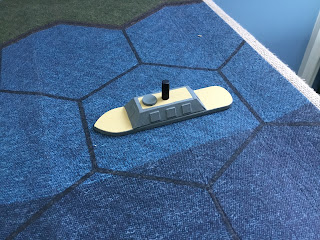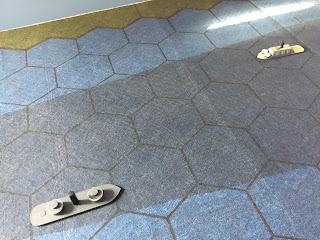Following on from the recent successful attempt to break out of the Blackwater River by the C.S.S. Secessionist the Confederate command decided that a further ship should force the patrol lines and make their way to Immobile Bay. The two ironclads still up river at the small port of Hullbridge were now complete and ready for action although one was to be retained for local defence alongside the various other gunboats in in use. The C.S.S. O’Hara (Captain Butler commanding) was therefore ordered to make the attempt. As an aside Captain Butler had campaigned rigorously to make the attempt as he had important business in Immobile Bay that was vital to the Confederacy.
It was known that the Union employed monitors to patrol the junction with the Missenhitti and it was believed that due to the damage sustained by the U.S.S. Hiawatha in the recent battle with the C.S.S. Secessionist that only a single ship was immediately available.
What the Rebels did not know was the identity of the ship that was tasked with protecting the vital Blackwater junction.
The Combatants
The initial dispositions.
Turn 1. There was no firing from either side. The Union rolled a 1 for initiative opposed to the Confederate 3 so they moved first. Both sides maintained course and speed so moved 2 hexes straight ahead.
End of Turn 1. Note that the distance between the two ships is now 8 hexes or maximum gun range.
Turn 2. Both sides are able to fire - all firing is simultaneous - and do so. The U.S.S. Senator opens fire with her forward turret with two heavy guns. These roll 3d6 each but deduct 1d6 for the range meaning that 5d6 are rolled in all. The scores are 1, 2, 3, and two 5s so there are two potential hits on the Rebel ship. The Rebel player now rolls for his saving throw. As a ship with heavy protection he is able to roll 3d6. He rolls two 5s and a 6 meaning that he has ‘negated’ 4 hits - as he had only suffered 2 the damage was comfortably avoided. The Rebel ship fires back. Her forward gun is a single medium rifle so 2d6 are rolled. The 1d6 deduction for range is offset by the additional d6 for being a rifle thus reflecting the weapons accuracy. The Rebel ship rolls a 1 and a 2 so misses entirely. For initiative the Rebel ship rolls a 5 whilst the Union rolls a 6 so the Confederates move first. Both ships turned so as to enable their full broadsides to be brought to bear with the Union ship looking to occupy the centre of the channel.
End of Turn 2. Both sides attempt to get the most amount of guns to bear on their opposite number. The Union certainly have the advantage in this case with their turret mounted artillery.
Turn 3. The C.S.S. O’Hara opens fire with her forward facing medium rifle at a range of 6 hexes. Again she rolls 2d6 with 2d6 being her base roll, minus 1d6 for the range and plus 1d6 for being a rifle. She rolls a 1 and a 6 meaning that there two potential hits arising from he roll of 6. The 1 is of course a miss. The U.S.S. Senator rolls 3d6 for its heavy protection saving roll. The roll gives a 1, a 2 and a 6 meaning that the two potential hits have been negated. It is now the Union turn to fire and with both turrets able to bear it could potentially be very effective.
Rule on the fly. I have decided that turrets must be fired individually and that gun types can only be massed if they are of the same weight. Also, rifled weapons are fired separately. The deduction for range is applied to individual guns. Light guns may always fire at long range with 1d6 but do not get the bonus for being rifled if applicable. I will need to think about this further.
Each turret has two heavy guns meaning a base of 6d6 each. However each gun loses a d6 as they are smoothbore weapons firing at long range, This means that each turret fires 4d6. The U.S.S. Senator rolls four 3s, two 4s, a 5 and a 6 meaning there are 5 potential hits. The C.S.S. O’Hara rolls her 3d6 to save and gets a 3, a 5 and a 6 meaning that she saves 3 out of a possible 5 hits. Two hits are recorded on her damage chart. Both sides roll for initiative. The Union roll a 1 whilst the Rebels roll a 6 so the U.S.S. Senator moves first. Both vessels turn into one another with the Rebel ship desperate to bring her full broadside to bear. This far she has been fighting with a single rifle so is heavily outgunned.






2 comments:
A nice AAR that has a nice level of detail on your rules modifications David. Once again I love the look of the ships:)
Hi Steve J,
Thanks old chap! The rules had that ‘close, but no cigar’ feel about them but I think I may have just about ironed it out. What I really need to do is to run a further play test to polish it off.
That will be next then!
All the best,
DC
Post a Comment